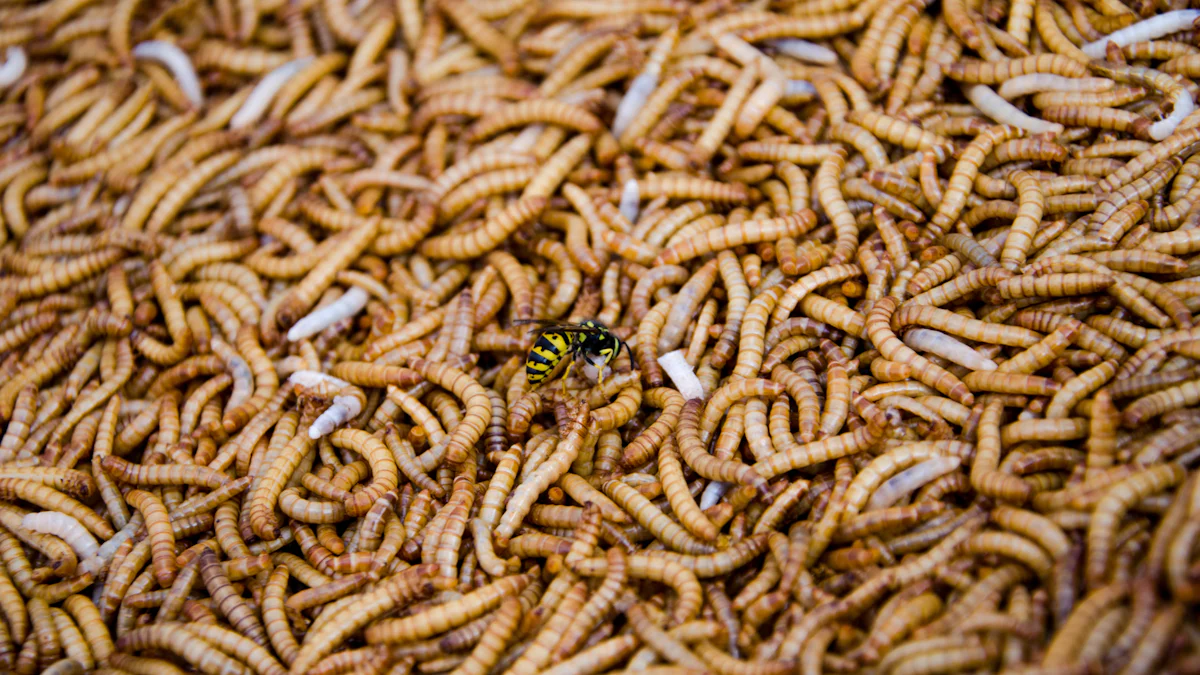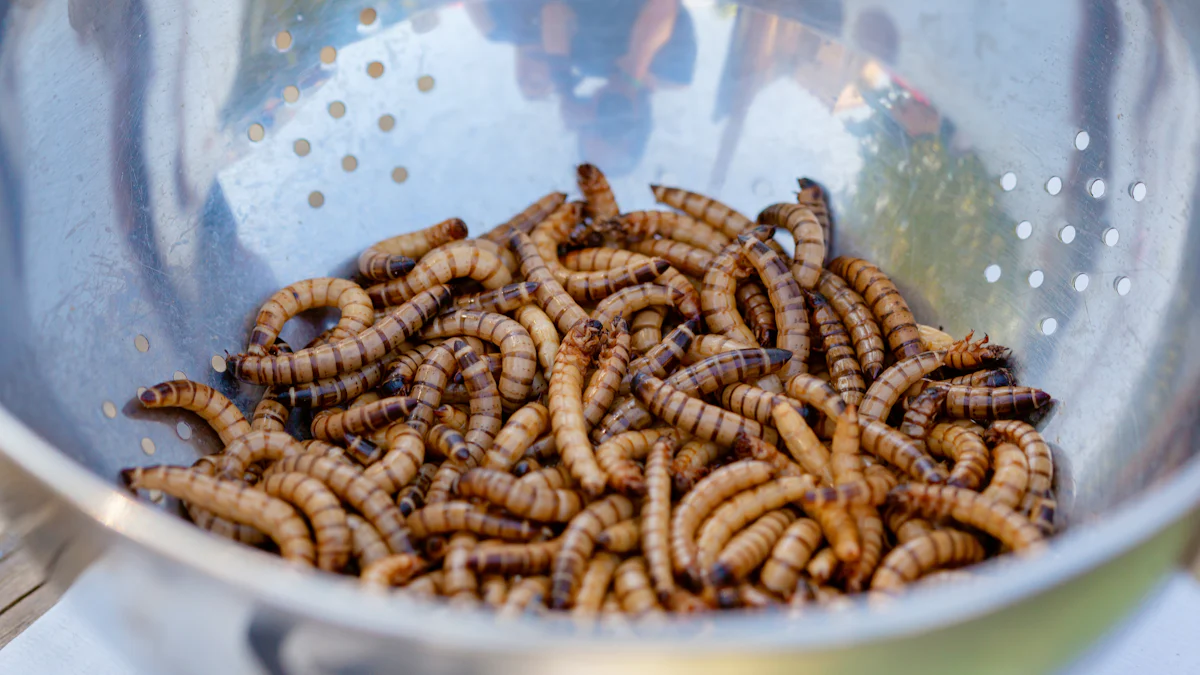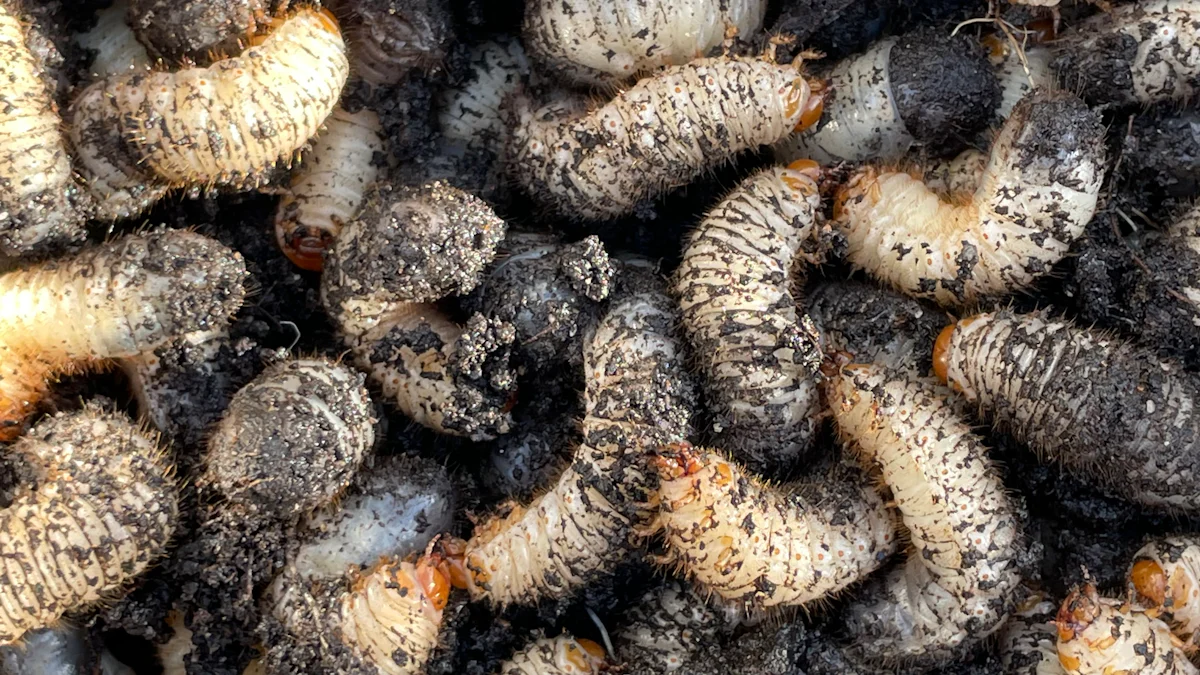
Mealworm farming offers a fascinating and efficient way to produce sustainable protein. These tiny creatures require minimal resources, making them an environmentally friendly choice. Mealworms thrive on organic waste materials, transforming them into nutritious mealworm feed. This process not only reduces waste but also provides a low-carbon alternative to traditional livestock farming. Mealworms emit significantly less CO2 and require less space compared to larger farm animals. Their ability to grow in various substrates highlights their versatility and potential as a sustainable protein source. Dive into the world of mealworm farming and discover its simplicity and benefits.
Key Takeaways
- Mealworm farming is an eco-friendly way to produce sustainable protein, utilizing organic waste and requiring minimal resources.
- Choose shallow plastic containers with good ventilation to create an optimal habitat for mealworms, ensuring they thrive in temperatures between 70°F and 80°F.
- Provide a balanced diet of organic waste materials, including wheat bran and raw vegetables, to meet the nutritional needs of mealworms and keep them hydrated.
- Regular cleaning and maintenance of the mealworm habitat are essential to prevent disease and promote healthy growth.
- Mealworms can significantly reduce waste and contribute to sustainability by converting organic materials into valuable protein for pets and livestock.
- Monitor temperature and humidity levels closely to avoid common issues like mold growth and ensure a thriving mealworm colony.
- Incorporating mealworms into diets for pets and livestock can enhance health and productivity, making them a valuable addition to sustainable farming practices.
Materials and Tools Required
Embarking on the journey of mealworm farming requires a few essential materials and tools. These items ensure that mealworms thrive in a healthy environment, transforming organic waste into nutritious mealworm feed.
Essential Materials
Containers and Housing
Choosing the right container is crucial for mealworm farming. Containers for Mealworm Farming should have a large surface area to accommodate the growing mealworms. A shallow plastic container works well, as long as the larvae remain at least an inch below the top to prevent escape. Many farmers find success keeping these containers in a laundry room, garage, or basement. Adequate ventilation is vital to manage moisture levels, preventing mold growth and pest infestations. Regular checks help maintain the ideal conditions for mealworm growth.
Substrate Options
The substrate serves as both bedding and food for mealworms. Common options include wheat bran and rolled oats. A layer about 2-3 inches deep provides a comfortable habitat. If the substrate feels damp, adding dry wheat bran or oatmeal can absorb excess moisture. This simple adjustment keeps the environment optimal for mealworm development.
Mealworm Feed and Water Sources
Mealworms require a steady supply of mealworm feed to grow efficiently. They thrive on organic waste materials, which they convert into nutritious feed. Providing moisture is equally important. Raw vegetables like carrots, potatoes, or apples offer hydration without the risk of drowning, unlike regular water sources. These vegetables also contribute to the mealworms’ nutritional intake, ensuring they remain healthy and active.
Tools for Maintenance
Cleaning Supplies
Maintaining a clean environment is essential for mealworm health. Basic cleaning supplies, such as brushes and cloths, help remove waste and debris from the containers. Regular cleaning prevents the buildup of harmful bacteria and ensures the mealworms have a fresh habitat.
Monitoring Equipment
Monitoring equipment, like thermometers and hygrometers, plays a crucial role in mealworm farming. These tools help track temperature and humidity levels, ensuring they remain within the optimal range of 70°F to 80°F. Consistent monitoring allows for timely adjustments, promoting efficient mealworm growth.
Setting Up Your Mealworm Farm

Embarking on the journey of mealworm farming involves creating a cozy and efficient habitat for these tiny creatures. This section will guide you through the essential steps to set up your mealworm farm, ensuring a thriving environment for your mealworms.
Preparing the Housing
Choosing the Right Container
Selecting the perfect container forms the foundation of a successful mealworm farm. A shallow plastic container with a large surface area works best. It should be deep enough to prevent mealworms from escaping but shallow enough to allow easy access for maintenance. Many farmers find that keeping these containers in a warm, dark place like a garage or basement provides an ideal environment. Mealworms thrive in temperatures between 70°F and 80°F, so maintaining this range is crucial.
Modifying for Ventilation
Proper ventilation plays a vital role in mealworm farming. Without it, moisture can build up, leading to mold growth and unhealthy conditions. To ensure adequate airflow, modify the container by drilling small holes in the lid or sides. This simple adjustment helps maintain the right humidity levels, keeping the mealworms healthy and active.
Adding Substrate and Hiding Places
Selecting the Best Substrate
The substrate serves as both bedding and a food source for mealworms. Wheat bran and oatmeal are popular choices, providing essential nutrients for growth. A layer about 2-3 inches deep creates a comfortable habitat. If the substrate feels damp, adding dry wheat bran can help absorb excess moisture, ensuring an optimal environment for mealworm development.
Creating Hiding Spots
Mealworms love to burrow and hide, so providing hiding spots enhances their habitat. Adding pieces of cardboard or egg cartons gives them places to explore and feel secure. These hiding spots mimic their natural environment, promoting healthy behavior and growth.
Introducing Mealworms
Sourcing Healthy Mealworms
Starting with healthy mealworms sets the stage for a successful farm. Purchase mealworms from reputable suppliers who provide robust and disease-free larvae. Inspect them for signs of health, such as active movement and a shiny appearance.
Proper Introduction Techniques
Introducing mealworms to their new home requires care. Gently place them on top of the substrate, allowing them to burrow naturally. Avoid overcrowding, as this can lead to stress and competition for resources. Providing a steady supply of mealworm feed, such as organic waste materials, ensures they have the nutrients needed for growth.
By following these steps, anyone can create a thriving mealworm farm. With the right setup, mealworms will efficiently convert organic waste into nutritious mealworm feed, offering a sustainable protein source for various applications.
Ongoing Maintenance
Mealworm farming requires consistent care to ensure a thriving colony. Regular maintenance keeps mealworms healthy and productive, transforming organic waste into valuable mealworm feed.
Feeding and Watering
Nutritional Requirements
Mealworms need a balanced diet to grow efficiently. They thrive on a variety of organic waste materials, which they convert into nutritious mealworm feed. Providing a mix of wheat bran, oats, and vegetable scraps ensures they receive essential nutrients. Observing their feeding habits helps adjust the diet to meet their needs, promoting robust growth and development.
Watering Methods
Hydration plays a crucial role in mealworm health. Instead of using water dishes, which pose a drowning risk, offer moisture through raw vegetables like carrots or potatoes. These vegetables provide necessary hydration while contributing to the mealworms’ nutritional intake. Regularly check the moisture levels in the substrate to maintain an optimal environment.
Cleaning and Upkeep
Regular Cleaning Schedule
Maintaining a clean habitat prevents disease and promotes healthy growth. A regular cleaning schedule involves removing waste and uneaten food from the containers. Use brushes and cloths to keep the environment tidy. Consistent cleaning reduces the risk of harmful bacteria and ensures mealworms have a fresh space to thrive.
Managing Waste
Efficient waste management enhances the sustainability of mealworm farming. Mealworms produce frass, a byproduct that can enrich garden soil. Collect and compost this waste to create a nutrient-rich fertilizer. Regularly monitor the condition of the substrate and replace it when necessary to maintain a healthy habitat.
Carol Heeson, an expert in mealworm farming, emphasizes the importance of regular health checks. “Observing behavior and condition during routine maintenance helps catch and address potential issues early,” she notes. This proactive approach ensures successful and sustainable mealworm farming.
By following these maintenance steps, mealworm farmers can create a thriving environment. Mealworms will efficiently convert organic waste into nutritious mealworm feed, offering a sustainable protein source for various applications.
Nutritional Benefits of Mealworms

Protein Content
Mealworms pack a punch when it comes to protein. These tiny critters boast a high protein content, making them a powerhouse of nutrition. They rival traditional protein sources like beef and chicken, offering a well-balanced amino acid profile. This makes mealworms an excellent alternative for those seeking sustainable protein options. Their nutritional value even compares favorably to fish and soybean meal, which are known for their protein richness.
Mealworms serve as an ideal feed for pets such as birds, reptiles, and fish. Their high protein content supports pet health and vitality, ensuring your feathered or scaly friends thrive. Pet owners often notice increased energy levels and improved overall well-being in their pets when mealworms become a part of their diet.
Environmental Impact
The environmental impact of mealworm farming is impressively low. Unlike traditional livestock, mealworms require minimal resources to produce. They can be raised on organic waste materials, transforming what would otherwise be discarded into valuable protein. This ability to thrive on waste makes mealworms an environmentally friendly feed option.
Scientific Research Findings:
- Mealworms emit significantly less CO2 compared to conventional livestock like cows and pigs.
- They require less space and water, making them a sustainable choice for large-scale production.
In poultry and livestock farming, mealworms show great potential. Incorporating them into the diets of chickens, pigs, and cattle can enhance production performance and improve meat quality. Farmers may observe better growth rates and healthier animals, thanks to the nutrient-rich profile of mealworms.
“Mealworms should be considered a more sustainable source of edible protein compared to conventional sources like milk, chicken, pork, or beef,” notes a study on lifecycle assessment for mealworm production. This highlights their role as a sustainable food source for both humans and animals.
By choosing mealworms, individuals and farmers alike contribute to a more sustainable future. These little insects offer a big solution to the growing demand for protein, all while minimizing environmental impact.
Troubleshooting Common Issues
Mealworm farming, like any other agricultural endeavor, can present challenges. Understanding how to identify and address these problems effectively can enhance your ability to raise mealworms successfully. Here’s a comprehensive guide to troubleshooting the most common issues faced by mealworm farmers.
Pest Control
Pests can pose a significant threat to mealworm farms. They compete for resources and can introduce diseases. To keep pests at bay, farmers should regularly inspect their mealworm habitats. Look for signs of unwanted visitors, such as mites or beetles. If pests are detected, remove them promptly.
Preventive Measures:
- Regular Cleaning: Maintain a clean environment to deter pests.
- Proper Storage: Store feed and substrate in sealed containers to prevent contamination.
- Natural Barriers: Use diatomaceous earth around containers to create a barrier against crawling insects.
Disease Prevention
Diseases can spread quickly in a mealworm colony, affecting growth and productivity. Farmers should monitor their mealworms for signs of illness, such as lethargy or discoloration. Quarantine affected mealworms to prevent the spread of disease.
Disease Prevention Tips:
- Hygiene: Keep the habitat clean and free from waste.
- Ventilation: Ensure proper airflow to reduce the risk of mold and bacterial growth.
- Regular Health Checks: Observe mealworms for any unusual behavior or appearance.
Managing Temperature and Humidity
Temperature and humidity play crucial roles in mealworm farming. Mealworms thrive in temperatures between 70°F and 80°F. Humidity levels should be carefully controlled to prevent issues.
Expert Insight:
“When humidity is too low, mealworm eggs dry out and the reproduction of the population decreases. With too much humidity, there is an increased risk of mold and mites. These molds and mites can make the mealworms sick. A system to control humidity is therefore definitely necessary when farming mealworms.”
Temperature and Humidity Management:
- Temperature Control: Use heaters or fans to maintain optimal temperatures.
- Humidity Regulation: Employ dehumidifiers or humidifiers as needed to keep humidity levels stable.
- Monitoring Tools: Utilize thermometers and hygrometers to track environmental conditions.
By addressing these common issues, mealworm farmers can ensure a healthy and productive colony. Regular monitoring and maintenance will help prevent problems and promote a thriving mealworm farm.
Efficient mealworm farming transforms organic waste into a sustainable protein source. By following key steps, anyone can create a thriving mealworm farm. Start with the right materials and tools. Set up a cozy habitat. Maintain regular feeding and cleaning routines. Troubleshoot common issues to ensure healthy growth. Mealworms offer an ideal feed for pets like birds, reptiles, and fish, boosting their health and vitality. They also hold potential in poultry and livestock farming, enhancing production performance and meat quality. Embrace mealworm farming with confidence and contribute to a sustainable future.
FAQ
What are mealworms, exactly?
Mealworms are the larval stage of the Darkling Beetle. They are small, worm-like creatures that transform into beetles as part of their life cycle. Mealworms are popular in farming due to their high protein content and ability to thrive on organic waste.
How do mealworms taste?
Mealworms have a unique, peanut-like taste. Many adventurous eaters find them quite delicious. Numerous recipes incorporate mealworms into everyday meals, offering a crunchy twist to traditional dishes. From stir-fries to baked goods, mealworms add a nutty flavor that surprises and delights.
Why should someone consider mealworm farming?
Mealworm farming offers a sustainable way to produce protein. These critters require minimal resources and can be raised on organic waste materials. This makes them an environmentally friendly feed option. By farming mealworms, individuals can reduce costs associated with purchasing commercial chicken feed supplements.
What materials are needed to start a mealworm farm?
Starting a mealworm farm requires a few essential materials. Farmers need shallow plastic containers, wheat bran or oatmeal for substrate, and raw vegetables like carrots for moisture. Basic cleaning supplies and monitoring equipment, such as thermometers, ensure a healthy environment for mealworms.
How do mealworms benefit pets?
Mealworms serve as an ideal feed for pets like birds, reptiles, and fish. Their high protein content supports pet health and vitality. Pet owners often notice increased energy levels and improved overall well-being in their pets when mealworms become part of their diet.
Can mealworms be used in poultry and livestock farming?
Yes, mealworms hold great potential in poultry and livestock farming. Incorporating them into the diets of chickens, pigs, and cattle can enhance production performance and improve meat quality. Farmers may observe better growth rates and healthier animals, thanks to the nutrient-rich profile of mealworms.
How do you maintain a mealworm farm?
Maintaining a mealworm farm involves regular feeding, cleaning, and monitoring. Mealworms need a balanced diet of wheat bran, oats, and vegetable scraps. Regular cleaning prevents disease, while monitoring temperature and humidity ensures optimal growth conditions.
What are the environmental benefits of mealworm farming?
Mealworm farming boasts impressive environmental benefits. Mealworms emit significantly less CO2 compared to conventional livestock. They require less space and water, making them a sustainable choice for large-scale production. By choosing mealworms, farmers contribute to a more sustainable future.
How do you control pests in a mealworm farm?
Controlling pests in a mealworm farm involves regular inspections and preventive measures. Farmers should maintain a clean environment and store feed in sealed containers. Using natural barriers like diatomaceous earth can help keep unwanted visitors at bay.
What should you do if mealworms show signs of disease?
If mealworms show signs of disease, such as lethargy or discoloration, farmers should quarantine affected individuals. Maintaining hygiene and proper ventilation reduces the risk of disease spread. Regular health checks help catch and address potential issues early, ensuring a healthy colony.


